| Listing 1 - 10 of 30 | << page >> |
Sort by
|
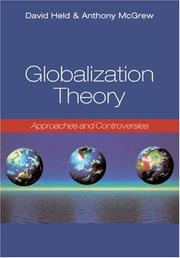
ISBN: 0745632106 0745632114 9780745632117 9780745632100 Year: 2007 Volume: v. 4 Publisher: Cambridge: Polity press,
Abstract | Keywords | Export | Availability | Bookmark
 Loading...
Loading...Choose an application
- Reference Manager
- EndNote
- RefWorks (Direct export to RefWorks)
Globalization. --- Mondialisation --- Globalization --- 316.32 --- 911.3:32 --- 911.3:33 --- Global cities --- Globalisation --- Internationalization --- International relations --- Anti-globalization movement --- 911.3:32 Geopolitiek. Politieke geografie --- Geopolitiek. Politieke geografie --- 316.32 Globale samenlevingsvormen --- Globale samenlevingsvormen --- Economic geography
Book
Abstract | Keywords | Export | Availability | Bookmark
 Loading...
Loading...Choose an application
- Reference Manager
- EndNote
- RefWorks (Direct export to RefWorks)
Dissertation
ISBN: 9789086490844 Year: 2007 Publisher: Leuven Katholieke Universiteit Leuven. Faculteit Wetenschappen
Abstract | Keywords | Export | Availability | Bookmark
 Loading...
Loading...Choose an application
- Reference Manager
- EndNote
- RefWorks (Direct export to RefWorks)
Het stroomgebied van de Suoi Muoi is een rurale regio in de bergstreek in het noordwesten van Vietnam. De bevolking van het stroomgebied van de Suoi Muoi bestaat uit verschillende etnische groepen zoals de Thai, de Kinh, de Khang, de Mong en de Khomu. Deze etnische groepen leven gescheiden van elkaar in aparte dorpen en volgen nog grotendeels hun eigen traditionele levensstijl die nauw samenhangt met de landbouwactiviteiten. De regio werd lang gedomineerd door feodale heersers van de Thai groep. Aan het einde van de jaren vijftig werd onder impuls van het socialistische regime een collectivisatie van de landbouwsector doorgevoerd. In de jaren zestig groeide het bevolkingsaantal in het stroomgebied sterk ten gevolge van immigratie. De staat organiseerde de migratie van Kinh die in de Vietnamese laaglanden woonden naar de minder dichtbevolkte bergstreken. Vanaf 1986 werd het collectieve productiesysteem waarbij iedere landbouwer een vast loon werd uitbetaald geleidelijk aan omgevormd naar een vrije markteconomie. De wetten van 1988 en 1993 regelden de herverdeling van het gemeenschappelijke landbouw- en bosareaal onder de verschillende families van het stroomgebied. Al deze veranderingen hadden een significante impact op het landgebruik en de bodembedekking in het stroomgebied van de Suoi Muoi. De meeste natuurlijke bos –en struikvegetatie werd verwijderd om het land te gebruiken voor akkerbouw. Teledetectiebeelden toonden aan dat het ruimtelijk patroon van deze landgebruiksveranderingen in het stroomgebied niet uniform is. Het voorgestelde onderzoek poogt de oorzaken en gevolgen van de geobserveerde landgebruiksveranderingen beter te begrijpen. Kwantitatieve en kwalitatieve onderzoeksmethoden werden aangewend om na te gaan in welk mate het ruimtelijk patroon van landgebruikveranderingen gecorreleerd is met fysische en socio-culturele variabelen. Allereerst werden historische landgebruiks- en bodembedekkingspatronen gereconstrueerd met behulp van verschillende ruimtelijke informatiebronnen. Het potentieel van zowel satellietbeelden als luchtfoto’s voor landschapsreconstructie werd onderzocht. Ten tweede werden logistische regressietechnieken gebruikt om na te gaan welke variabelen gecorreleerd zijn met de geobserveerde landgebruikspatronen zowel over korte als langere tijdsperioden. De resultaten van deze analyse toonden aan dat de factor ‘etniciteit’ in belangrijke mate de geobserveerde landgebruikspatronen verklaart. Om een dieper inzicht te krijgen in de wijze waarop de factor ‘etniciteit’ landgebruiksveranderingen controleert werden van een aantal bevoorrechte getuigen in zes dorpen met een verschillende socio-culturele achtergrond diepte-interviews afgenomen. Tenslotte werd in deze studie nagegaan in hoeverre de geobserveerde landgebruiksveranderingen een impact hebben op de natuurlijke omgeving rond de dorpen en op het totale sedimentbudget van het stroomgebied van de Suoi Muoi. De resultaten van dit onderzoekswerk zijn relevant voor het ontwerp van duurzame ontwikkelingsscenario’s door nationale en lokale beleidsmakers. The Suoi Muoi catchment is a rural area situated in the mountains of north-western Vietnam. The population of the Suoi Muoi catchment consists of different ethnic groups such as the Thai, the Kinh, the Khang, the Mong and the Khomu that live separately in small villages. Each ethnic group has their own traditional lifestyle and farming practices. In the early time, Thai feudal noblemen ruled the area. After revolution in 1945, socialist regime was installed, under which in late 1950s, a collective farming system was implemented. During that time, the population density in the catchment has increased significantly as a consequence of the state-organised immigration of Kinh people from the Vietnamese lowlands in 1960s. From 1981, collective system was turned to group-oriented system then after the renovation (doi moi) in 1986, the system has gradually transformed into open market economy. Under the first land law in 1988 and the revised law in 1993, land includes forest and agricultural land has been allocated to individual households. All these changes had a significant impact on the land use and land cover in the catchment. A lot of natural vegetation such forest and shrub land was converted into upland fields. Remote sensing imagery showed, however, that the spatial pattern of these land use changes is not uniform. The proposed research aimed at a better understanding of the causes and environmental consequences of land use changes in the Suoi Muoi catchment. Quantitative and qualitative research methods were applied in order to analyse to which extent the spatial pattern of land use changes is controlled by physical and socio-cultural variables. Firstly, historical land use and land cover patterns were reconstructed using various spatial data sources. The potential of both satellite images and aerial photos for landscape reconstruction was examined. Secondly, logistic modelling techniques were used to detect which variables are correlated with the observed land use change patterns of both short and longer time spans. This analysis made clear that the factor “ethnicity” was significantly correlated with the observed land use change patterns. In order to get a better understanding of the way the factor “ethnicity” controls land use change, in depth interviews in six villages with a different socio-cultural background were carried out. Finally, this study focused on the impact of the observed land use changes on the natural environment around the villages and on the total sediment budget of the Suoi Muoi catchment. The results presented in this work can be used by national and local authorities for the development of a sustainable land use policy in the region.
Academic collection --- 911.3:30 --- 911.2 --- Social geography --- Physical geography --- Theses
Book
ISBN: 9789023244110 Year: 2007 Publisher: Assen Van Gorcum
Abstract | Keywords | Export | Availability | Bookmark
 Loading...
Loading...Choose an application
- Reference Manager
- EndNote
- RefWorks (Direct export to RefWorks)
911.3:33 --- Economische geografie --- Netherlands --- Urban economics. --- Economic conditions. --- Economic geography
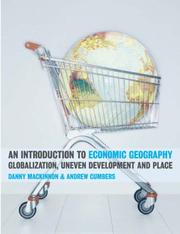
ISBN: 9780131293168 0131293168 Year: 2007 Publisher: Harlow: Pearson/Prentice Hall,
Abstract | Keywords | Export | Availability | Bookmark
 Loading...
Loading...Choose an application
- Reference Manager
- EndNote
- RefWorks (Direct export to RefWorks)
Economic geography --- 911.3:33 --- arbeid --- economie, internationaal --- economische geografie --- globalisering --- multinationals --- research & development --- werkloosheid --- Economische geografie
Book
ISBN: 9783980959247 3980959244 Year: 2007 Publisher: Münster : Institut für Geographie der Westfälischen Wilhelms- Universität,
Abstract | Keywords | Export | Availability | Bookmark
 Loading...
Loading...Choose an application
- Reference Manager
- EndNote
- RefWorks (Direct export to RefWorks)
Regionalentwicklung.
---
Landwirtschaftsentwicklung.
---
Irland
Book
ISBN: 9789087560249 Year: 2007 Publisher: Zelzate Nautilus
Abstract | Keywords | Export | Availability | Bookmark
 Loading...
Loading...Choose an application
- Reference Manager
- EndNote
- RefWorks (Direct export to RefWorks)
910.1 --- 911.3 --- 911.3:32 --- 711 --- 728 --- Geografie als wetenschap:--grondbeginselen: theorieën --- Sociale geografie. Culturele geografie --- Geopolitiek. Politieke geografie --- Ruimtelijke ordening. Planologie. Stedebouw --- Particuliere bouwkunst. Woningbouw --- Geografie --- Sociale en economische geografie --- Verzamel- en mengelwerken. --- 911.3:32 Geopolitiek. Politieke geografie --- 728 Particuliere bouwkunst. Woningbouw --- 711 Ruimtelijke ordening. Planologie. Stedebouw --- Ruimtelijke planning en ruimtelijk ontwerp --- Algemene theoretische werken.
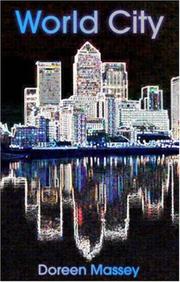
ISBN: 9780745640600 0745640591 0745640605 9780745640594 Year: 2007 Publisher: Cambridge Polity press
Abstract | Keywords | Export | Availability | Bookmark
 Loading...
Loading...Choose an application
- Reference Manager
- EndNote
- RefWorks (Direct export to RefWorks)
316.334.56 --- 911.3 --- Stadssociologie--(algemeen) --- Human geography. Cultural geography --- Human geography --- Sociology, Urban --- London (England) --- Economic conditions. --- Geography. --- Social conditions. --- 316.334.56 Stadssociologie--(algemeen)
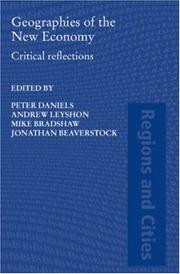
ISBN: 0415357837 9780415357838 0203003896 9780203003893 9781134325429 9781134325467 9781134325474 9780415493512 Year: 2007 Publisher: London Routledge
Abstract | Keywords | Export | Availability | Bookmark
 Loading...
Loading...Choose an application
- Reference Manager
- EndNote
- RefWorks (Direct export to RefWorks)
Economic geography --- Economic history --- Technological innovations --- 338 <09> --- 911.3:33 --- Geography, Economic --- World economics --- Geography --- Commercial geography --- 338 <09> Economische geschiedenis --- Economische geschiedenis --- Economic aspects
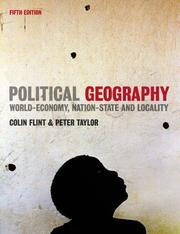
ISBN: 9780131960121 0131960121 Year: 2007 Publisher: Harlow (England): Pearson/Prentice Hall,
Abstract | Keywords | Export | Availability | Bookmark
 Loading...
Loading...Choose an application
- Reference Manager
- EndNote
- RefWorks (Direct export to RefWorks)
International relations. Foreign policy --- Social geography --- International economic relations --- Political geography --- Geopolitics --- 844.1 Sociale geografie --- 831 Internationale politieke economie --- 824 Globalisering --- 814 Theorie van de internationale betrekkingen --- 242 Nationaliteitenproblemen, Nationalisme --- 827 Geopolitiek --- 911.3:32 --- Geopolitiek. Politieke geografie --- Geopolitics. --- Political geography. --- 911.3:32 Geopolitiek. Politieke geografie --- Geography, Political --- Human geography --- World politics --- 844 Sociale structuur
| Listing 1 - 10 of 30 | << page >> |
Sort by
|

 Search
Search Feedback
Feedback About UniCat
About UniCat  Help
Help News
News